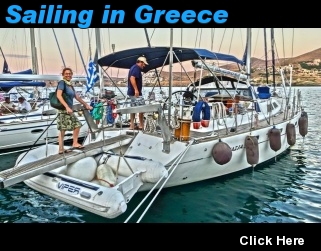|
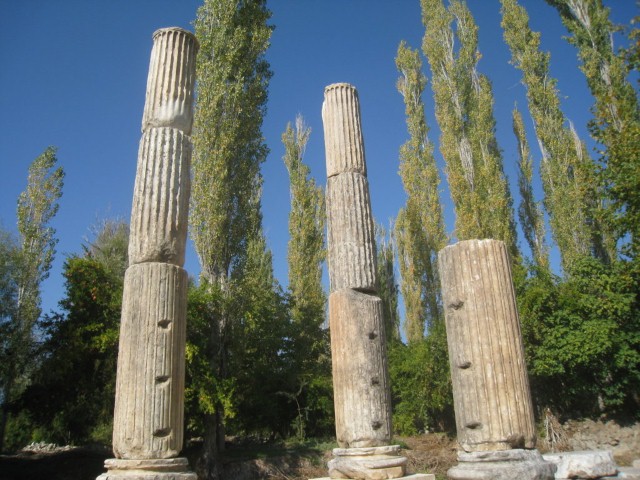
|
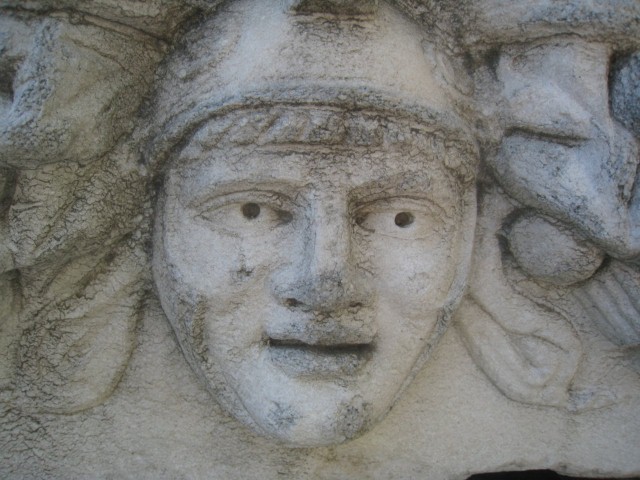
|
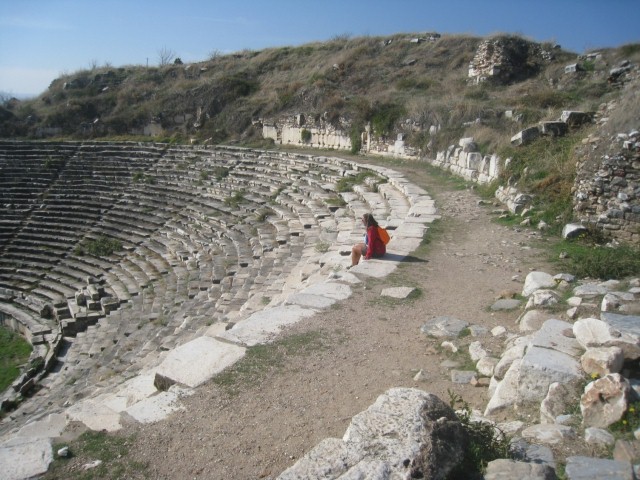
|
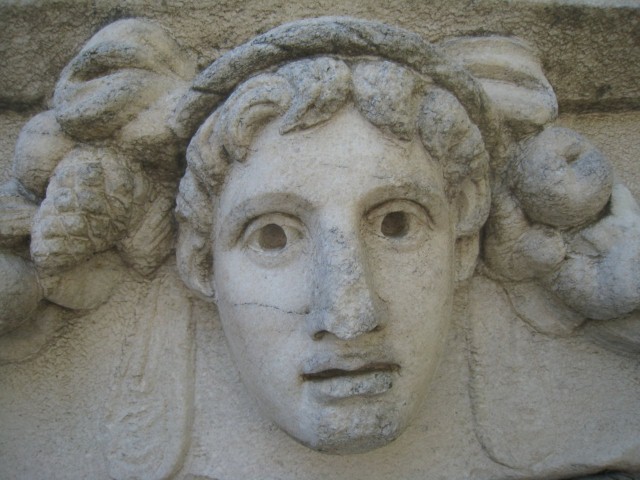
|
Afrodisias
by Colleen McGuire
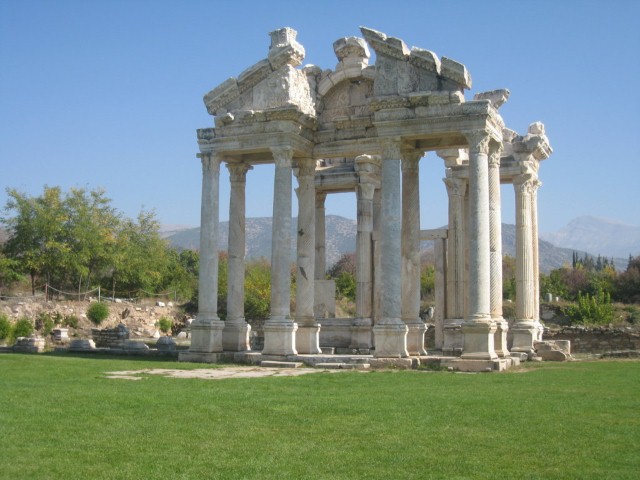 The spectacular archaeology site of Afrodisias sits in the shadow of Ephesus like a kid sister competing against the established praise
and popularity of
her older sibling. The simple reason for Ephesus’ greater fame boils down to two words: cruise ships. Each year 650 cruise ships call on Kusadasi’s port hauling around 650,000 passengers and almost every one of them goes to Ephesus. Why not Afrodisias? Cruise travelers have a daily curfew requiring a return
to port at a designated hour or the ship leaves without them. A twenty minute transfer to Ephesus is safer than risking a six hour round-trip drive from Kusadasi to Afrodisias. The spectacular archaeology site of Afrodisias sits in the shadow of Ephesus like a kid sister competing against the established praise
and popularity of
her older sibling. The simple reason for Ephesus’ greater fame boils down to two words: cruise ships. Each year 650 cruise ships call on Kusadasi’s port hauling around 650,000 passengers and almost every one of them goes to Ephesus. Why not Afrodisias? Cruise travelers have a daily curfew requiring a return
to port at a designated hour or the ship leaves without them. A twenty minute transfer to Ephesus is safer than risking a six hour round-trip drive from Kusadasi to Afrodisias.
A remote interior location has advantages, primarily the unlikelihood that crowds will jostle you. Afrodisias’ acreage probably matches that of Ephesus, but without swarms of camera toters it feels so much larger. Its rural, unspoilt setting contributes to a sense of spaciousness in contrast to the density of Ephesus’ urban ruins. A pastoral calm envelops Afrodisias as if you’re apt to see cows grazing on the expansive grassy fields. Actually, there’s a
terrific exhibition at Afrodisias of black and white photographs taken in the1960s poignantly depicting bucolic scenes of local peasants farming a plot of land or herding goats amidst Afrodisia’s ancient ruins.
|
|
My twin sister Cat and I pulled up to a fairly empty parking lot and were soon directed by a man to jump aboard the shuttle bus. We didn’t know then that the walk to Afrodisias’ entrance only takes ten minutes, but since the man didn’t appear to speak English we obeyed his hand gestures and got inside. Waiting for us was a busload of boisterous British school boys on a scholastic trip. They made furtive glances at the only females on board but forgot all about
us when we
reached
the entry point. The chaperon rallied his wards together and marched them off to the north, prompting us to set off decisively due south. Whereas the two entry sidewalks at Ephesus compel visitors to move through that site pretty much in one single direction (upward or downward), Afrodisias’ ruins are more scattered so that guests can choose among several walkways as their beginning exploration point.
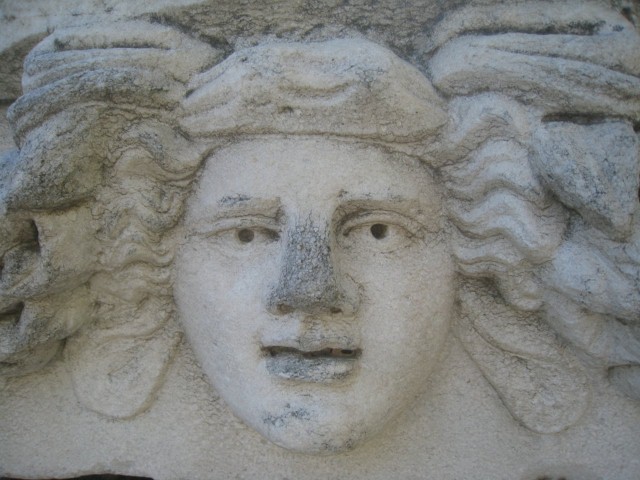 The first ruins Cat and I observed were scores and scores of sculpted heads in bas relief carved on white marble facades that had fallen over the years. Each face has its own distinctive look and personality so intense
that the features
surely derived from human models rather than from the imagination of the sculptor. We found the portraits totally bewitching. Who were these individuals? What were their states of mind that produced such depths of expression frozen
for posterity? The first ruins Cat and I observed were scores and scores of sculpted heads in bas relief carved on white marble facades that had fallen over the years. Each face has its own distinctive look and personality so intense
that the features
surely derived from human models rather than from the imagination of the sculptor. We found the portraits totally bewitching. Who were these individuals? What were their states of mind that produced such depths of expression frozen
for posterity?
The existence of so many marble portraits was possible due to a bountiful local marble quarry. Its rich lode enabled Afrodisias to establish a sculpting school which in turn helped the city become an influential art and cultural center. The school’s output bore an aesthetic style recognized as distinctly Afrodisian and as such its statuary was in demand throughout the Greek and Roman world. I regretted photographing only a few of the faces but there were really
too many
– enough
to populate a little village – so we had to move on.
|
|
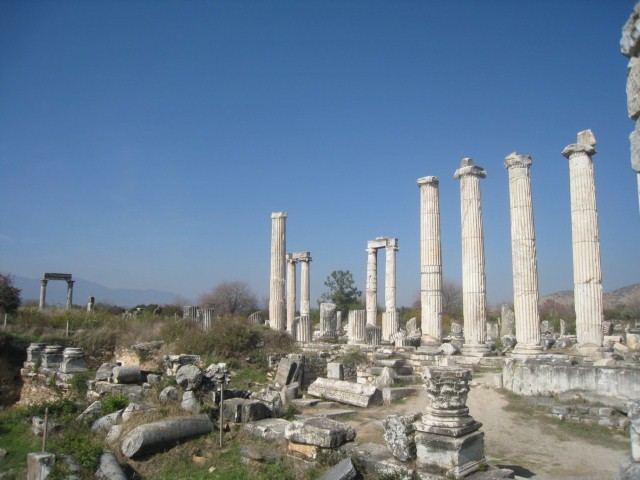 While Artemis was the queen divinity at Ephesus, Aphrodite, the goddess of love, was the cult of choice at Afrodisias. The majestic Temple of Aphrodite built from a marble as white as a bride’s
wedding gown
was also
a sanctuary meaning that it provided safe refuge for whoever reached its steps. Several thousand years later the temple still has at least a dozen columns standing magnificently tall in the sylvan panorama. Equally awesome is the Tetrapylon, the massive
white marble gate that led worshippers to the Temple of Aphrodite. This treasured structure was in unrecognizable ruins until Dr. Kenan Erim, a Turkish archaeology professor from New York University, restored and erected the portal to its former grandeur. Upon receiving a grant from National Geographic in 1961 Dr. Erim essentially rescued Afrodisias from oblivion by devoting his life work to its excavation. Fittingly, Dr. Erim is buried in a sarcophagus -- an above ground tomb --
next to the Tetrapylon. A plaque describes his achievements and his passion for the grounds that became his final resting place among the gods. While Artemis was the queen divinity at Ephesus, Aphrodite, the goddess of love, was the cult of choice at Afrodisias. The majestic Temple of Aphrodite built from a marble as white as a bride’s
wedding gown
was also
a sanctuary meaning that it provided safe refuge for whoever reached its steps. Several thousand years later the temple still has at least a dozen columns standing magnificently tall in the sylvan panorama. Equally awesome is the Tetrapylon, the massive
white marble gate that led worshippers to the Temple of Aphrodite. This treasured structure was in unrecognizable ruins until Dr. Kenan Erim, a Turkish archaeology professor from New York University, restored and erected the portal to its former grandeur. Upon receiving a grant from National Geographic in 1961 Dr. Erim essentially rescued Afrodisias from oblivion by devoting his life work to its excavation. Fittingly, Dr. Erim is buried in a sarcophagus -- an above ground tomb --
next to the Tetrapylon. A plaque describes his achievements and his passion for the grounds that became his final resting place among the gods.
Speaking of tombs, there are dozens of stone sarcophagi scattered around Afrodisias particularly adorning the museum’s lawn where they are methodically lined up like the inventory of a marble-crazed mortician. Each piece is an impeccable work of art with detailed garland carvings, bas relief portraits or scenes on four sides that tell some kind of momentous story. Many were probably dug up by Dr. Erim in his thirty year tenure at Afrodisias during which he triumphed
in excavating
the
major monuments there. My sister and I managed to see most of Afrodisias’ masterful constructions and reconstructions, although we lamented the lack of a guide or proper guidebook. Consequently, we were puzzled by many things, such as, why the Theatre also had theTheatre Baths. Were they for the actors or the audience? Did the sarcophagi with lids still have bodies in them?
Touring a paramount archaeology site like Afrodisias without a professional guide is akin to watching a movie with the sound turned off. Near the stately Council House, the equivalent of a Parliament, we re-encountered the English teen-agers and couldn’t help but notice how their teacher appeared quite well versed in the lay of the land. Whereas we initially fled from them, now we lingered nearby shamelessly eavesdropping on their teacher’s illuminating lecture.
When the
roving classroom continued due south with a slight reluctance we resumed our northerly direction. Our disappointment that the ticket window didn’t rent audio tapes was compounded by our brush with this mere high school guide whose elocution in a crisp British accent made him sound more scholarly than he probably was.
|
|
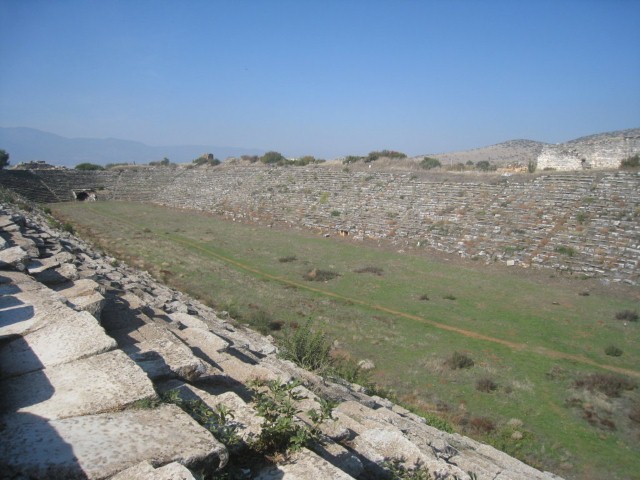 A tremendous highlight of Afrodisias is the enormous hippodrome, measuring more than two football fields long. It is probably the biggest and certainly the best preserved stadium in all the Mediterranean. We counted 26
rows of seats
constructed
of white marble (what else!) on both sides, plus the curved ends. That’s ample space for thousands of fans to cheer on gladiators and charioteer races. Sources differ on the hippodrome’s seating capacity with estimates ranging
from 30,000 to 60,000. Although Ancient Olympia’s stadium in Greece is older by more than a half dozen centuries. a first-time visitor to Olympia is startled to discover that, except for VIPs, there was no seating for the spectators other than the surrounding sloped grassy lawns. Comparably, the marble bleachers of Afrodisias’ hippodrome were downright plush by ancient standards. A tremendous highlight of Afrodisias is the enormous hippodrome, measuring more than two football fields long. It is probably the biggest and certainly the best preserved stadium in all the Mediterranean. We counted 26
rows of seats
constructed
of white marble (what else!) on both sides, plus the curved ends. That’s ample space for thousands of fans to cheer on gladiators and charioteer races. Sources differ on the hippodrome’s seating capacity with estimates ranging
from 30,000 to 60,000. Although Ancient Olympia’s stadium in Greece is older by more than a half dozen centuries. a first-time visitor to Olympia is startled to discover that, except for VIPs, there was no seating for the spectators other than the surrounding sloped grassy lawns. Comparably, the marble bleachers of Afrodisias’ hippodrome were downright plush by ancient standards.
|
|
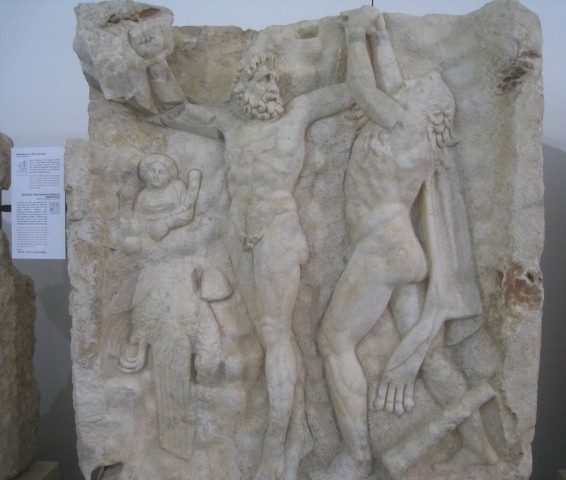 Since the price of a ticket to Afrodisias includes entry to its superb museum, a visit inside is imperative. Of course everything on display is marble statuary, nary
a fresco
or shard of
pottery in sight. Many of the antiquities were segments from temple pediments depicting the potent mythological tales of the day. There is the finely carved slab of Hercules performing a scene from his Eleventh Labor in which he rescues Prometheus from a mountain where he was chained and
subjected to an eagle eating his liver. This was Zeus’ punishment because Prometheus stole the secret of fire from the gods. Another intricate marble carving relates the saga of Achilles and Penthesilea, an Amazon daughter of Ares. She accidentally killed her sister on a hunting trip and went to Troy to seek absolution. She joins the Trojans in war and kills a Greek enemy. In retaliation Achilles kills her in battle but then falls in love with the dead warrior. These
types of heroic epics put to marble occupy the largest room in the museum accompanied by lively descriptions of the myths. Since the price of a ticket to Afrodisias includes entry to its superb museum, a visit inside is imperative. Of course everything on display is marble statuary, nary
a fresco
or shard of
pottery in sight. Many of the antiquities were segments from temple pediments depicting the potent mythological tales of the day. There is the finely carved slab of Hercules performing a scene from his Eleventh Labor in which he rescues Prometheus from a mountain where he was chained and
subjected to an eagle eating his liver. This was Zeus’ punishment because Prometheus stole the secret of fire from the gods. Another intricate marble carving relates the saga of Achilles and Penthesilea, an Amazon daughter of Ares. She accidentally killed her sister on a hunting trip and went to Troy to seek absolution. She joins the Trojans in war and kills a Greek enemy. In retaliation Achilles kills her in battle but then falls in love with the dead warrior. These
types of heroic epics put to marble occupy the largest room in the museum accompanied by lively descriptions of the myths.
|
|
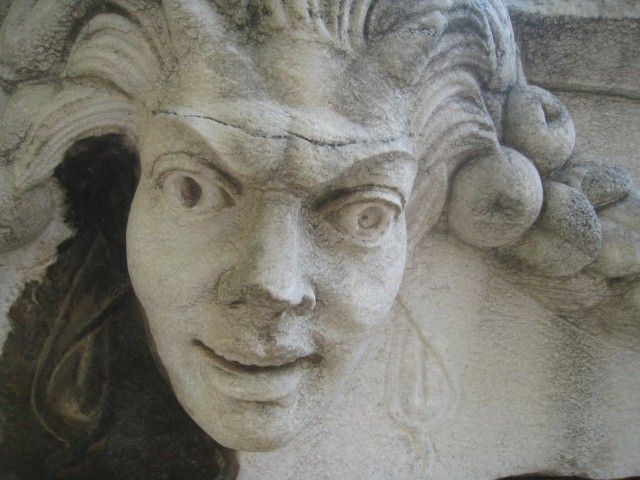 Unlike Ephesus where the museum is located three kilometers away in Selcuk, the museum of Afrodisias greets you as you enter or exit the grounds. The museum was our last stop and we were near completion when the young Brits showed up en masse. In contrast
to the outdoors
where
their shrill adolescent voices got carried away in the air, their rambunctious presence in the closed confines of the museum turned the subdued halls into something akin to a school playground at recess. Unlike Ephesus where the museum is located three kilometers away in Selcuk, the museum of Afrodisias greets you as you enter or exit the grounds. The museum was our last stop and we were near completion when the young Brits showed up en masse. In contrast
to the outdoors
where
their shrill adolescent voices got carried away in the air, their rambunctious presence in the closed confines of the museum turned the subdued halls into something akin to a school playground at recess.
With their teacher in contemplation somewhere on his own, the boys were free to let loose their boy energy. Most scurried from one marble piece to the next, probably under instructions to be back at the bus in twelve minutes, or some such time restriction. They all wielded tiny cameras and we overheard one youngster boast, “I’ve got over 1000 photos in my iPod.” Although we should commend these kids for not taking a field trip to a paintball park, yet and still
their
invasion of the museum prompted my sister and me to depart without seeing the last couple exhibit rooms.
The goddess Hera inflicted Hercules with a bout of temporary insanity causing him to kill his wife and children. As punishment he was ordered to perform Twelve Labors, feats so difficult they seemed impossible. Oh, that Hercules would have been handed a Thirteenth Labor – ridding the Afrodisias museum of excess testosterone at the moment the McGuire twins were passing through.
|
Travel Information
For hotels in Kusadasi/Ephesus see Booking.com's Turkey Hotels
For hotels in Selcuk see Booking.com's Turkey Hotels
For a reliable travel agency see Fantasy Travel who can book your holiday all over Turkey as well as Greece and the Greek Islands.
You can get between Ephesus and the Greek Island of Samos by ferry from Kusadasi
|
|



 The first ruins Cat and I observed were scores and scores of sculpted heads in bas relief carved on white marble facades that had fallen over the years. Each face has its own distinctive look and personality so intense
that the features
surely derived from human models rather than from the imagination of the sculptor. We found the portraits totally bewitching. Who were these individuals? What were their states of mind that produced such depths of expression frozen
for posterity?
The first ruins Cat and I observed were scores and scores of sculpted heads in bas relief carved on white marble facades that had fallen over the years. Each face has its own distinctive look and personality so intense
that the features
surely derived from human models rather than from the imagination of the sculptor. We found the portraits totally bewitching. Who were these individuals? What were their states of mind that produced such depths of expression frozen
for posterity?  Unlike Ephesus where the museum is located three kilometers away in Selcuk, the museum of Afrodisias greets you as you enter or exit the grounds. The museum was our last stop and we were near completion when the young Brits showed up en masse. In contrast
to the outdoors
where
their shrill adolescent voices got carried away in the air, their rambunctious presence in the closed confines of the museum turned the subdued halls into something akin to a school playground at recess.
Unlike Ephesus where the museum is located three kilometers away in Selcuk, the museum of Afrodisias greets you as you enter or exit the grounds. The museum was our last stop and we were near completion when the young Brits showed up en masse. In contrast
to the outdoors
where
their shrill adolescent voices got carried away in the air, their rambunctious presence in the closed confines of the museum turned the subdued halls into something akin to a school playground at recess. 